Justice For George Floyd Timeline: Witness Who Tried To Stop Murder Wins $150K Settlement
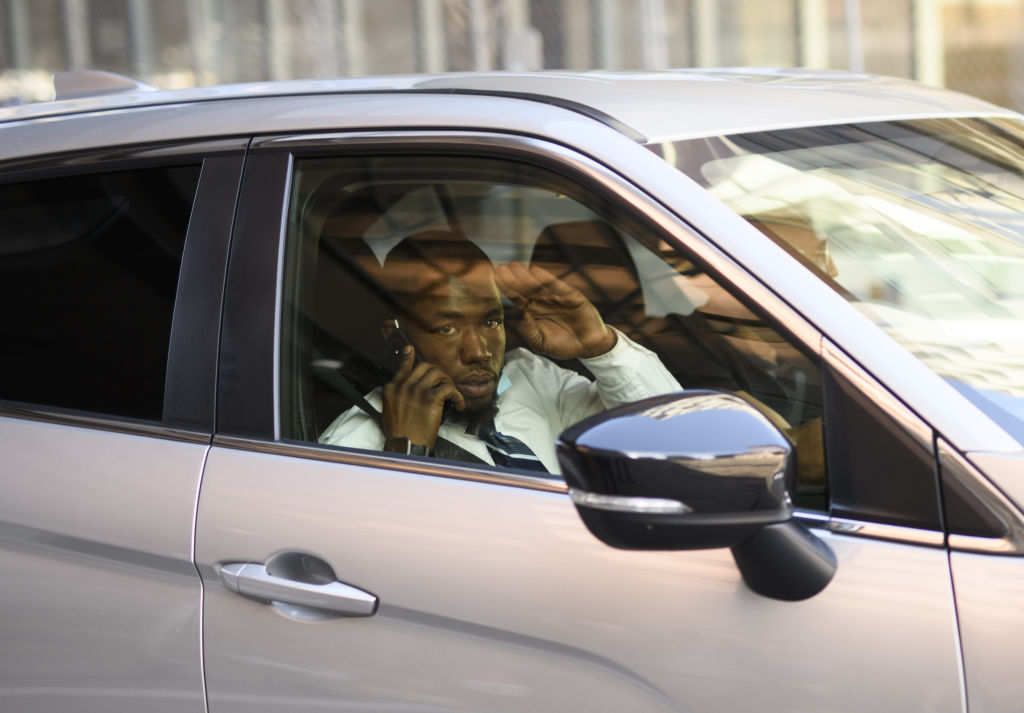
Source: Stephen Maturen / Getty
UPDATED: 4:15 p.m. ET, April 26, 2024
An eyewitness who tried to help prevent George Floyd’s murder has settled a lawsuit with the city of Minneapolis after police assaulted him during the 2020 incident.
On Thursday, the Minneapolis City Council agreed to pay Donald Williams a $150,000 settlement, approving the money without much discussion, according to AP.
Williams, who sued the city last year, alleged his encounter with police caused post-traumatic stress disorder. In his lawsuit, the mixed martial arts fighter claimed former Minneapolis police officer Derek Chauvin used a chemical spray on him and other bystanders concerned for George Floyd. Williams stated in the lawsuit that he feared for his safety and also endured pain throughout the incident.
Williams also testified against Chauvin during his murder trial and described the chokehold the former officer used on Floyd as what MMA fighters call a “blood choke.”
Donald Williams, who witnessed George Floyd’s death, said he made a 911 call “because I believe I witnessed a murder.”
— Jaylin aka Mr.President
(@JaylinJSD) March 30, 2021
Williams also testified against Chauvin during his murder trial and described the chokehold the former officer used on Floyd as what MMA fighters call a “blood choke.”
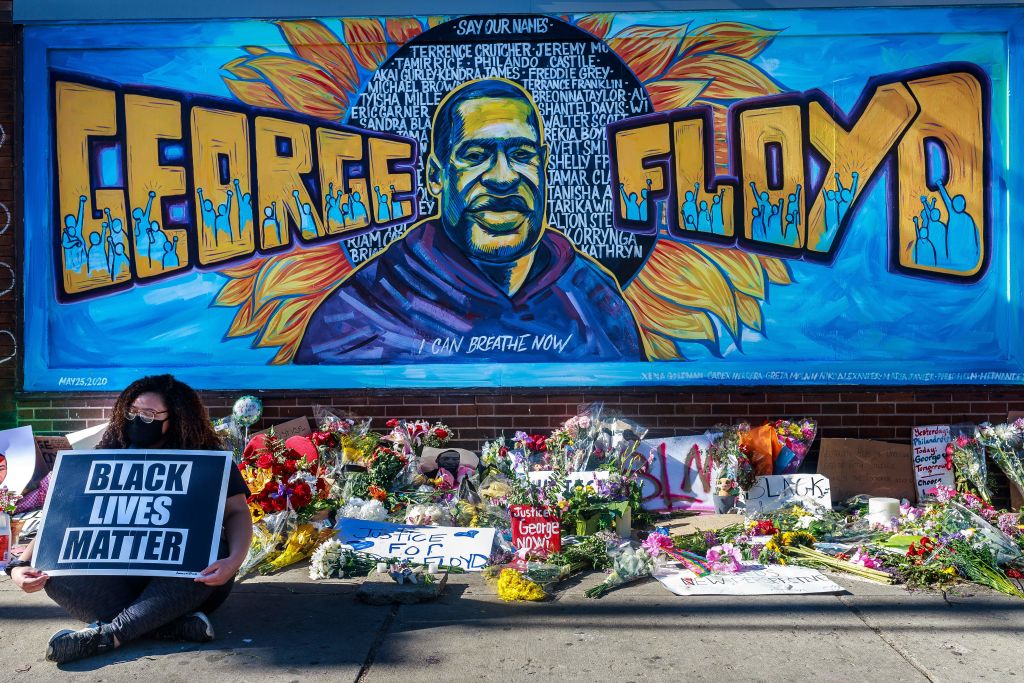
Next month marks the fourth since George Floyd was murdered by Derek Chauvin. As the wheels of justice have spun slowly but surely, this year is the first time the anniversary of the brazen police killing has come and all of the officers involved have been fully held accountable for their roles on May 25, 2020.
Keep reading to find a complete and detailed timeline of the ongoing quest to bring justice for George Floyd.
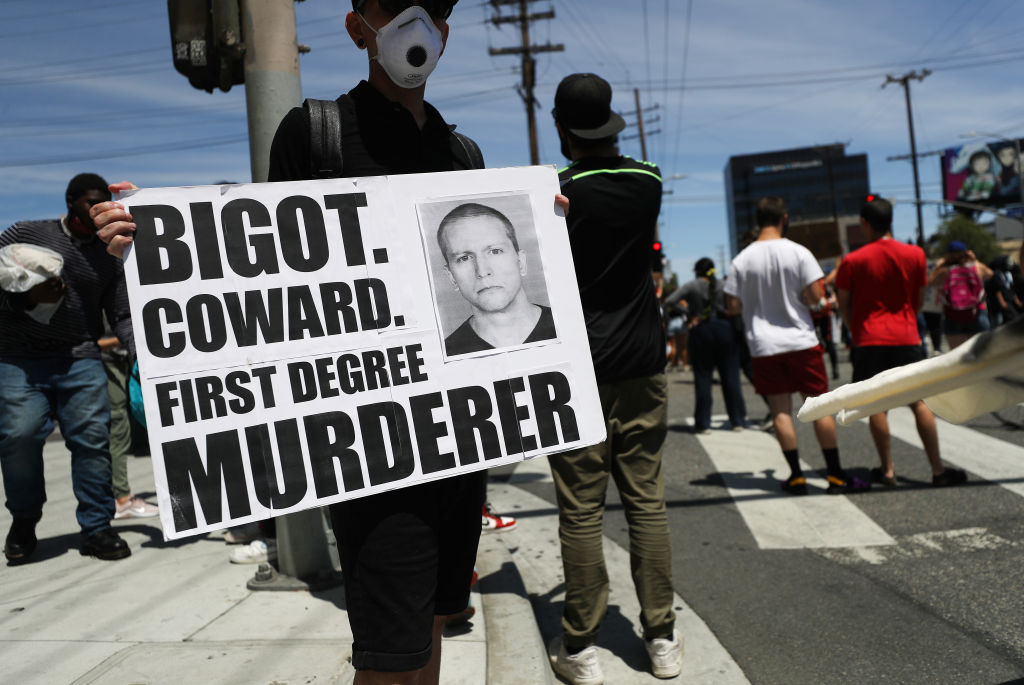
Source: Mario Tama / Getty
The fallout continues
Chauvin and the three officers who failed to intervene in the murder of Floyd — J. Alexander Kueng, Thomas Lane, and Tou Thao — were all behind bars and expected to stay there for years to come following their convictions in federal and state courts.
Chauvin continues to file desperate motions requesting a new trial, but thus far those efforts have been unsuccessful as he serves a sentence of more than 20 years in prison.
Last summer, Thao and Kueng rejected their plea deals from the state and decided to stand trial instead. They both were also convicted on federal charges of violating Floyd’s civil rights. Thao was sentenced to serve 42 months in prison and Kueng was sentenced to serve 36.
During their federal trial, an off-duty firefighter and a Paramedic both testified for the prosecution in the federal case against three former police officers who assisted Chauvin. Both witnesses testified in Chauvin’s trial, as well.
Minneapolis firefighter, Genevieve Hansen, took the stand and testified that she witnessed Floyd’s head under the knee of Chauvin as other officers helped hold him down. The sight of Floyd struggling to breathe made Hansen angry enough to get loud with the officers.
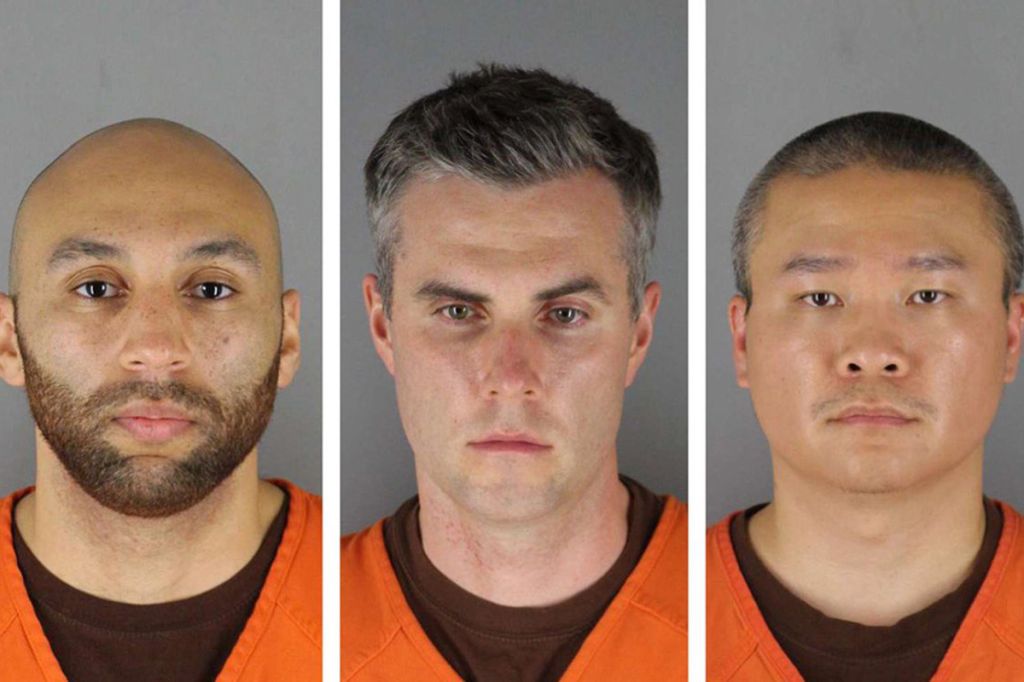
From left: Former Minneapolis police officers Tou Thao, J. Alexander Kueng and Thomas Lane. | Source: U.S. Minnesota Department of Corrections and Hennepin County Sheriff’s Office
“It was just alarming, the amount of people that were on top of one person not moving and handcuffed,” said Hansen during testimony. “[Floyd] needed help and he wasn’t getting it.”
Hansen also testified that she asked former officer Thao to check if Floyd had a pulse, but Thao ignored the request and instead told her if she was a firefighter then she knew better than to get involved.
Paramedic Derek Smith testified that as he arrived on the scene, he was never told Floyd wasn’t breathing and had no pulse. When Smith arrived on the scene he recalled not being able to find a pulse in Floyd’s neck and that he was probably deceased. Smith also testified that Floyd should have been given CPR as soon as possible and officers didn’t call in critical information that could have saved Floyd’s life.
At least one witness for the prosecution testified that he thought Floyd would die during his fatal encounter with Chauvin in 2020, according to reports from the federal trial against three former Minneapolis police officers.
The prosecution played the video footage from Floyd’s death, prompting 61-year-old witness Charles McMillian to get emotional while viewing it. McMillian was there on the scene when Floyd was killed and can be heard in the video.
He told the court that it was evident Floyd was going to be killed, the Associated Press reported.
“I knew something bad was going to happen to Mr. Floyd,” McMillian testified.
“What did you mean by that?” prosecutor Allen Slaughter asked.
“That he was gonna die,” McMillian responded.
McMillian was shown on surveillance video as well as bodycam footage from the multiple officers involved, pleading with Floyd to calm down. As the footage was replayed in court, McMillian broke down crying and needed to take a brief break before his testimony resumed because he said he felt “helpless.”
Chauvin trial witness Charles McMillian, who spoke with George Floyd before he was killed, breaks down in tears after watching video of Floyd calling out for his mother and saying that he can’t breathe. pic.twitter.com/WCLu9KmH3K
— The Recount (@therecount) March 31, 2021
The transcript from bodycam footage from Floyd’s murder scene shows that Lane was super aggressive toward Floyd despite the nonviolent nature of the alleged offense of using a counterfeit bill at a convenience store.
The defense’s strategy to the mostly white jury was clear from the beginning of the trial: Place all the blame squarely on the shoulders of Chauvin, who was the senior officer on the scene that fateful day on May 25, 2020, when the defendants violated Floyd’s civil rights by aiding and abetting and failing to stop the now-convicted murderer from using lethal force with his knee to the handcuffed Floyd’s neck for nearly nine minutes.
According to the Associated Press, one of the defense attorneys said that Chauvin called “all of the shots” during the encounter with Floyd. The defense also sought to convince jurors that the three defendants were not properly trained by the Minneapolis Police Department and did not know they were supposed to intervene.
However, Samantha Trepel — a prosecutor with the DOJ’s civil rights division — countered with facts like how Thao, Lane, and Kueng were all certified in CPR and saw Floyd dying yet did nothing to prevent his death.
“We will ask you to hold these men accountable for choosing to do nothing and watch a man die,” Trepel told the jury.
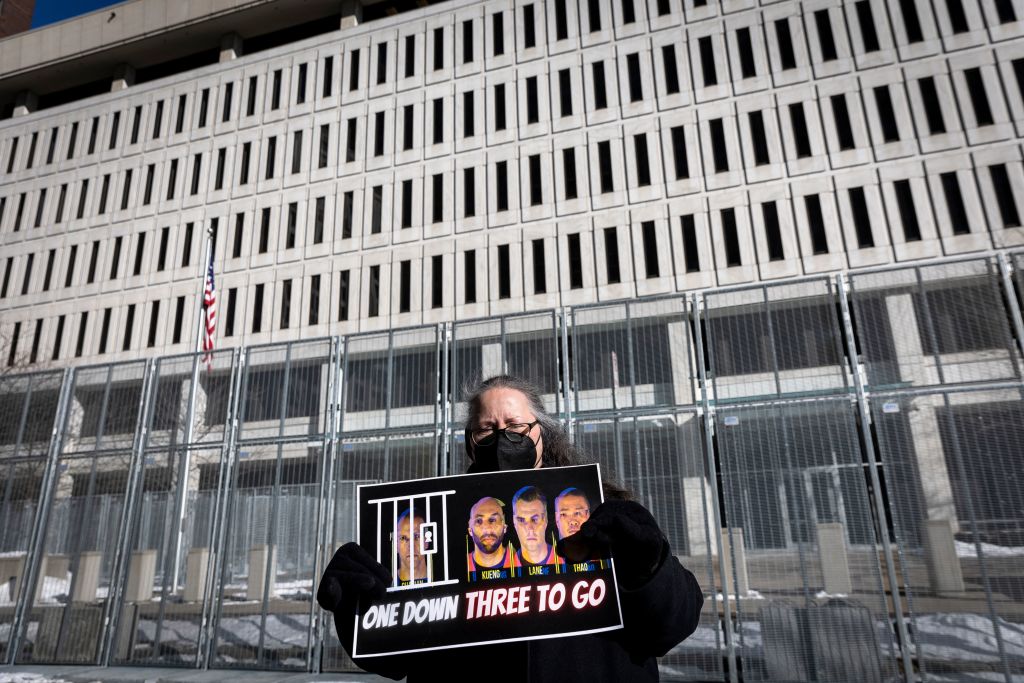
A community activist holds a placard during a press conference outside the U.S. District Court in St. Paul, Minnesota, on January 20, 2022, for the jury selection of three former Minneapolis police officers charged with federal civil rights violations in George Floyd’s death. | Source: KEREM YUCEL / Getty
The federal trial for the three former officers began about a month after Chauvin officially pleaded guilty to a pair of federal civil rights charges stemming from his murder of Floyd as well as a separate incident in which the former Minneapolis police officer injured a Black teenager.
Chauvin’s state trial
On April 20, 2021, Chauvin was unanimously found guilty of second-degree unintentional murder, third-degree murder, and second-degree manslaughter for killing Floyd. He was immediately handcuffed and remanded to prison from the courtroom following the reading of the verdict.
The jury took about 10 and a half hours to reach a verdict since beginning deliberations following closing arguments from the prosecution and the defense.
VERDICT REACHED IN THE DEREK CHAUVIN TRIAL IN DEATH OF GEORGE FLOYD
https://t.co/yqafE2IlMf
— Christal Hayes (@Journo_Christal) April 20, 2021
Cahill read the verdict aloud.
Prior to Cahill reading the jury their deliberations instructions, prosecutor Steve Schleicher strategically supplemented his closing remarks with video footage of Floyd’s death that emphasized Chauvin’s refusal to stop kneeling while cavalierly putting his hands in his own pockets.
Prosecutor says defense was shading the truth. He also said you have heard defense testimony that Mr. Floyd died because his heart was too big. The prosecution said Floyd died because Chauvin’s heart was too small. #DerekChauvinTrial
— AprilDRyan (@AprilDRyan) April 19, 2021
“This case is exactly what you thought when you saw it first,” prosecutor Steve Schleicher told the jury, referring to the viral video showing Floyd’s death on Memorial Day last year. “It’s exactly what you saw with your eyes. … It’s what you felt with your gut. It’s what you now know in your heart. This wasn’t policing. This was murder.”
Eric Nelson, Chauvin’s lead lawyer, followed that with a lengthy closing argument that attempted to place doubt about the medical examiner’s resolute declaration and testimony that Floyd’s manner of death was a homicide.
“You were told Mr. Floyd died because his heart was too big. After seeing the evidence, you know Mr. Floyd died because Derek Chauvin’s heart was too small”
— Prosecutor’s closing words in #DerekChauvinTrial
— Ana Navarro-Cárdenas (@ananavarro) April 19, 2021
“A reasonable doubt is a doubt that is based on reason and common sense,” Nelson said before adding later in his closing arguments: “This was an authorized use of force, as ugly as it might be, and this was reasonable doubt.”
The closing remarks were so lengthy, in fact, that Cahill had to intervene in order to allow the jury a chance to eat lunch after 2 p.m. local time.
#DerekChauvin counsel has tried to preserve 3 issues in case of appeal:
1. Failure to disclose data re carbon monoxide theory (albeit pro-prosecution)
2. Failure to sequester jury for duration of trial
3. Reinstatement 3rd degree murder charge#DerekChauvinTrial #GeorgeFloyd— Laura Coates (@thelauracoates) April 19, 2021
The defense and prosecution officially rested their cases after Chauvin spoke for the first time during the trial to officially decline the opportunity to testify in his own defense. That prompted the prosecution to re-examine one of its star witnesses — pulmonologist Dr. Martin Tobin — in an effort to further discredit unproven theories offered up one day earlier by pathologist Dr. David Fowler testifying for the defense about Floyd’s cause of death.
Dr. Tobin testifies that George Floyd’s carboxyhemoglobin level was at most two percent, contradicting Derek Chauvin’s defense witness who claimed yesterday that carbon monoxide poisoning from the police car contributed to George Floyd’s death. pic.twitter.com/N0aFq4VyrQ
— Keith Boykin (@keithboykin) April 15, 2021
After Cahill warned of a potential mistrial if Tobin “even mentions” the existence of tests that the prosecution failed to disclose in a timely fashion showing that Floyd had a normal carbon monoxide level. Doing so, Cahill said, would prejudice Chauvin. Still, Tobin cited it almost as soon as he took the stand, prompting Cahill to call an immediate sidebar, but not calling a mistrial.
NEW EVIDENCE: "It's going to be a mistrial, pure and simple."
Judge Cahill rules on the newly discovered evidence about carbon monoxide concentrations in #GeorgeFloyd’s blood.
WATCH LIVE – MN v. #DerekChauvin https://t.co/bis122QdFc pic.twitter.com/PYvZNbpkac
— Court TV (@CourtTV) April 15, 2021
Fowler previously testified that Floyd could have died from a number of factors that had nothing to do with Chauvin’s knee, including introducing the wild possibility that carbon monoxide poisoning from a police vehicle idling played an outsized role in the death. The prosecution quickly debunked Flowler’s theories while cross-examining him, but they still did their due diligence by calling Tobin to the stand to have an actual expert address add clarity and context to those claims.
Prosecutors rested their case after calling at least 40 witnesses.
Chauvin’s attorneys were clinging to their narrative that Floyd died from anything other than excessive force, including a possible fentanyl overdose. Among the defense’s witnesses was a former officer who interacted with Floyd during a 2019 arrest during his struggle with substance abuse, a paramedic who administered aid to Floyd during the 2019 arrest, and a woman who was with Floyd on the day he was killed by police.
Cahill told jurors the evidence presented from the previous arrest was not to serve “as evidence of the character of George Floyd,” but to show the effects of opioids on the body.
Barry Brodd, a former police officer and use-of-force expert called by the defense, attempted to poke holes in the prosecution’s theory, stating that he believed Chauvin’s actions were “justified” and objectively reasonable because he feels Floyd was resisting arrest.
“I felt that Derek Chauvin was justified, was acting with objective reasonableness, following Minneapolis Police Department policy and current standards of law enforcement in his interaction with Mr. Floyd,” Brodd said.
A second disturbing testimony came when Officer Peter Chang, who also responded to the scene that fateful day in 2020, told the jury that he was “concerned for the officers’ safety,” in reference to the crowd that gathered. Chang’s body camera footage was submitted as evidence, showing a different vantage point.
Chang also said he was worried because the crowd became “very aggressive.”
Just so we’re clear, officer Chang was concerned for the safety of four armed officers because of this “angry mob”. #ChauvinTrial pic.twitter.com/zGjmadfNfM
— Tamara (@513Tamara) April 13, 2021
Judge Cahill denied the defense’s request to sequester the jury in fear that the nearby police shooting of Daunte Wright — which happened during the trial in 2021 — could sway their opinion.
Judge Peter Cahill DENIES the defense's request to sequester the jury in the #DerekChauvinTrial. Defense wanted the jury isolated over the police shooting of Daunte Wright in nearby Brooklyn Center. Cahill said, "This is a totally different case."@AJEnglish
— John Hendren (@johnhendren) April 12, 2021
Philonise Floyd, Floyd’s brother, took the stand on Day 11 of the trial to help provide the jury with evidence pertaining to “spark of life doctrine” testimony.
Philonise understandably became emotional when talking about his brother and their upbringing in North Carolina. Philonise stated that George was known to be a “mommas boy,” and became inconsolable after losing their mother in 2018. The testimony harkened back to one of Floyd’s last moments where he cried for his mother as he took his last breaths under the weight of Chauvin’s knee.
Two more experts testified on behalf of the defense, adding that Floyd’s death was not caused by a drug overdose and that Chauvin’s used an “unacceptable or reasonable use of force,” as he restrained Floyd.
The second week of Chauvin’s murder trial concluded with testimony from more medical experts regarding Floyd’s cause of death, including Dr. Andrew Baker, the medical examiner for Minnesota’s Hennepin County, who told the courtroom that fentanyl and heart disease did not directly contribute to Floyd dying.
“In my opinion, the law enforcement subdual, restraint and the neck compression was just more than Mr. Floyd could take by virtue of those heart conditions,” Baker stated early in his testimony.
Baker ruled Floyd’s death a homicide, caused by “cardiopulmonary arrest complicating law enforcement subdual, restraint, and neck compression.”
Other expert witnesses for the prosecution testified about whether Chauvin’s use of excessive force fell within the MPD’s policy.
The defense continued a line of questioning based on whether George Floyd’s reported drug use caused his demise and if the crowd restricted Chauvin’s ability to render Floyd aid.
Many observed that the “blue wall of silence” may be crumbling Chauvin at the conclusion of Day 8 following expert testimony from Jody Stiger, a Los Angeles Police Department sergeant who took the stand for the prosecution and said that after reviewing video evidence, he concluded that Chauvin knelt on Floyd’s neck for the entirety of the time of when officers restrained Floyd on the ground, to when EMT’s arrived.
"I did not perceive them as being a threat," Sgt Jody Stiger on the people gathering near Derek Chauvin and the other officers. When asked why, he said because they were just filming and most of their comments were concern for Mr. Floyd. Stiger is a prosecution expert witness.
— Omar Jimenez (@OmarJimenez) April 7, 2021
Controversy also ensued over defense lawyer Eric Nelson who alleged that Floyd yelled out “I ate too many drugs” during his arrest. Multiple witnesses told the defense that they could not make out that phrase on the video.
On social media, many noted that the audio was too difficult to describe and admonished the defense for inferring something that was not definite. Observers believe that Floyd is actually saying, “I ain’t do no drugs.”
The second week of Chauvin’s murder trial included two important testimonies regarding the medical procedures, or the possibilities of the lack of procedures, administered at the scene of Floyd‘s murder, as well as whether Chauvin operated within the policies regarding the use of excessive force.
Dr. Bradford Langenfeld, the medical professional who pronounced Floyd dead after trying to resuscitate him opened Day 6 and testified that Floyd’s heart most likely stopped due to a lack of oxygen. Langenfeld said that when Floyd was brought to Hennepin County Medical Center, he was not made aware of any efforts made at the scene by bystanders or police to resuscitate him. Langenfeld said the chance of a patient’s survival goes down 10 to 15 percent every minute CPR is not performed.
Minneapolis Police Chief Medaria Arradondo, a veteran of the force after joining the Minneapolis Police Department in 1989, said he believed Chauvin’s actions directly violated the standing policy.
“That action is not de-escalation,” Arradondo said. “And when we talk about the framework of our sanctity of life and when we talk about our principles and the values that we have, that action goes contrary to what we are talking about.”
Day 4 of Chuavin’s trial brought forth multiple new revelations about Floyd’s personal life as well as the protocol that the former Minneapolis police officer accused of murder was expected to follow.
Courteney Ross, who identified herself as Floyd’s girlfriend, provided poignant testimony about their relationship and offered crucial insight into her drug use. She said they used opioid pills together and discussed how they tried and failed on multiple occasions to break their addictions.
Ross painted a picture of Floyd that showed a God-fearing, kind and loving family man who was battling his own demons — the antithesis of how the defense is portraying him. Calling Ross to the stand was a successful exercise in both humanizing Floyd and pushing back against the narrative of a violent drug addict, legal analysts said.
After two EMTs testified about arriving at the scene to find Chauvin and other officers on top of Floyd, the police supervisor who was working May 25 took the stand and addressed the controversial knee restraint the defendant employed.
David Pleoger, who has since retired from the Minneapolis Police Department, said Chauvin initially told him Floyd was going “crazy [and] wouldn’t go in the back of the squad.” But then Pleoger dealt the latest blow to the defense when he undermined their entire strategy of blaming Floyd for his own death.
“When Mr. Floyd was no longer offering up any resistance to the officers, they could have ended their restraint,” Pleoger testified after the prosecution asked him whether Chauvin used excessive force by kneeling on Floyd’s neck for more than nine minutes.
That testimony followed prosecutors playing yet additional video that was previously unseen to the public, prompting a series of emotional breakdowns from witnesses who provided damning testimony against the defendant.
Among the revelations presented in court was Chauvin’s stated justification for kneeling on Floyd’s neck for more than nine minutes — the action that led to the former Minneapolis police officer’s murder charge.
One of the most compelling witnesses to take the stand was Christopher Martin, who was working as a cashier at the Cup Foods store where Floyd is accused of trying to use a counterfeit $20 bill. Martin testified that he carried “guilt” with him because he is the one who notified the store’s manager of the bill before the police were called.
“If I would have just not taken the bill, this could have been avoided,” Martin said.
Martin’s testimony came one day after other eyewitnesses, including first responders and local residents who watched as Floyd took his final breath.
Witness and former MMA fighter Donald Williams previously supplied compelling testimony with a contentious exchange with Chauvin’s attorney.
During the questioning, Nelson attempted to drill down Williams, who thwarted the attempt at every turn. Social media users marveled at the harsh dual reality of Williams’ restraint while reliving the trauma of watching a man die.
Williams was seen emotional on the stand after playback of the 911 call he made reporting that he “witnessed a murder.”
Darnella Frazier, the Minneapolis teen who filmed the chilling footage of Chauvin kneeling on Floyd’s neck, recounted her daily trauma in the courtroom.
“There have been nights I stayed up apologizing and apologizing to George Floyd for not doing more and not physically interacting and not saving his life,” she said. “But it’s like not what I should have done, it’s what he (Chauvin) should have done.”
In another emotional moment, Frazier’s nine-year-old cousin took the bench and shared she was disappointed in Chauvin’s response when she saw him kneeling on Floyd.
Darnella Frazier's 9-year-old cousin testified that Derek Chauvin had to be moved off of George Floyd's neck by EMTs.
Of seeing this, she said, "I was sad and kind of mad … cause it felt like he was stopping his breathing and kind of like hurting him."
— Yamiche Alcindor (@Yamiche) March 30, 2021
And an off-duty firefighter said that she felt obligated to stay around the crime scene after Floyd died in order to protect witnesses from the police.
Still struck by this: Genevieve Hansen, the off-duty firefighter on the scene as George Floyd died, said she stayed on scene after Floyd was taken away bc she worried about the Black people and people of color –like Donald Williams — possibly being hurt by remaining police.
— Yamiche Alcindor (@Yamiche) March 30, 2021
Day 1 got off to a fast start with the prosecution and defense making their dueling opening arguments, making it apparent the different directions each legal team prefers. The day saw a couple of compelling witnesses as well as one underwhelming one while each side tries to build a case that fits their respective narratives.
Here they go blaming yet another Black body for dying. I don't care if George Floyd was on drugs or had a heart condition. You can take a healthy man and let another man kneel on his neck for 9 minutes and 29 seconds and he'll be strangled to death too.
— Stacey Patton (@DrStaceyPatton) March 29, 2021
The prosecution countered those claims by immediately showing the jury the video of Floyd’s arrest, including new footage, seemingly frame by frame to hammer home their stance that Chauvin intentionally killed the man who was only suspected of passing a counterfeit bill, a decidedly nonviolent offense.
Several witnesses were called, including a 911 dispatcher who was able to witness Floyd’s death in real-time from surveillance footage filmed across the street from the scene. The dispatcher, Jena Scurry, she said at one point she was concerned that the screen froze — a reference to how long Chauvin kneeled on Floyd’s neck while casually putting his hands in his pockets as onlookers warned of impending death.
Another witness, Alysha Oyler, was working across the street at a gas station when Chauvin and four other Minneapolis cops tried to arrest Floyd. Oyler eventually got closer and recorded the scene on her phone. However, despite her vantage point, Oyler repeatedly said she couldn’t remember specifics and laughed several times awkwardly during moments that were absent of humor. Her testimony didn’t seem to contribute much, if anything, to the prosecution as the defense likely revelled in her court appearance.
Alysha Oyler, the Prosecutions #2 witness who can't remember where she's lived in AZ, did no preparation for her testimony other than to paint her nails, affix fake eyelashes, and probably smoke a joint.#DerekChauvin #Alysha #WhiteTrash pic.twitter.com/20PTVRDsma
— Brian Riley (@BrianRi3976) March 29, 2021
The final witness of Day 1, however, was widely credited for his testimony that fell in line with the seeming consensus that Chauvin knew what he was doing and wanted to kill Floyd. Donald Williams III, a mixed martial artist who the prosecution established as an expert witness, described the neck restraint employed by Chauvin as deadly. He was one of the people who gathered at the scene outside of the store where the arrest was taking place and verbally warned all of the officers, including Chauvin, that Floyd would die if he didn’t ease up the pressure from his neck. In what seemed like a pivotal moment in the trial even though it was only the first day, Williams said he saw Floyd “slowly fade away.”
Witness says he saw #GeorgeFloyd 'slowly fade away' during arrest#DerekChauvin #ChauvinTrial pic.twitter.com/PMibA6vGah
— Ruptly (@Ruptly) March 30, 2021
The fate of Chauvin, who was seen on video casually applying what appeared to be deadly pressure to Floyd’s neck for about nine minutes on May 25, now rested in the hands of a 15-person panel that included three Black men, one Black woman and two women identified as being of “mixed-race.” The other nine jurors, including alternates, were white.
Members of Floyd’s family met with civil rights leaders for a prayer service that included calls for peace during and after the trial.
Rev. Al Sharpton, who was at the vigil at Greater Friendship Missionary Baptist Church in Minneapolis, urged people to take a knee, according to the local Fox News affiliate.
‘The criminal justice system is on trial tomorrow. [Derek] Chauvin is in the courtroom, but America is on trial, Reverend Al Sharpton told family and friends of George Floyd gathered for a vigil in Minneapolis on Sunday pic.twitter.com/ghKzpvH5lc
— Reuters (@Reuters) March 29, 2021
“For 8 minutes and 46 seconds, we are going to take a knee in front of the courthouse to show the world how long it took for Chauvin to have his knee on that neck,” Sharpton said. “People didn’t understand how long that was,” he continued. “Until they stood.”
Multiple references to the video of Floyd’s arrest were made during the vigil, the Minneapolis Star-Tribune reported.
“I have faith that he will get convicted,” Floyd’s brother Philonise said of Chauvin. “Just like everybody who’s seen that video because the video is the proof.
However, yet another video of Chauvin and Floyd was also relevant to the trial. That other footage came from a separate encounter between the two men in 2019 during a different traffic stop in which Floyd was accused of drug possession. While critics argue that the footage is irrelevant, Judge Cahill sided with defense attorneys “that the incident was relevant in that it offers proof of how Floyd’s body responded to drugs he admitted he had taken,” the Washington Post reported.
Philonise Floyd and Attorney Ben Crump join me live from Minneapolis 1 day before the Derek Chauvin trial begins to speak on the continued fight for justice for George Floyd, the George Floyd Justice and Policing Act, and more. https://t.co/NhpKUVk6uU#PoliticsNation pic.twitter.com/fV2OMfLws0
— Reverend Al Sharpton (@TheRevAl) March 28, 2021
Cahill made multiple rulings early that quickly affected the case’s trajectory, including previously denying a motion to delay or move the trial.
“Unfortunately, I think the pretrial publicity in this case will continue no matter how long we continue it. Perhaps some of it may, with time, be forgotten by people,” Cahill said at the time. “And as far as change of venue, I do not think that that would give the defendant any kind of a fair trial beyond what we are doing here today.”
That ruling followed Chauvin’s attorneys filing the motion as a result of a $27 million Minneapolis city settlement for George Floyd’s family.
Two jurors were ultimately dismissed over concerns that their impartiality could be tainted by that multi-million dollar settlement. One juror was a white man in his 30s while another was a Hispanic man in his 20s. The dismissal of two jurors was notable but also hinted that the perceived fallout over the settlement did not have as large of an effect as thought.
“I don’t think there is any place in the state of Minnesota that has not been subjected to extreme amounts of publicity on this case,” Cahill said for that ruling.
Cahill also reinstated the third-degree murder charges that he previously dismissed against Chauvin. That charge has been added to the second-degree unintentional murder and second-degree manslaughter Chauvin was already facing.
(!) Judge grants prosecution request to add third-degree murder charge against ex-officer Derek Chauvin who is charged in George Floyd’s death.
— Yamiche Alcindor (@Yamiche) March 11, 2021
The additional charge carried a maximum penalty of up to 25 years in prison and increased the likelihood of a conviction on at least one of the charges.
Cahill’s decision was a reversal from his previous ruling to drop the charges on a legal technicality. For the third-degree murder charges to stick, the law requires that someone cause the death of another person while committing an act inherently dangerous to others. After an appeals court ruled against Cahill’s decision in October, Cahill changed his stance and reinstated the charge.
WATCH LIVE: The Judge explains why he granted the motion to reinstate the third-degree murder charge against #DerekChauvin in the death of #GeorgeFloyd.
WATCH LIVE – MN v. #DerekChauvin on #CourtTV https://t.co/tnYdPcDRMU pic.twitter.com/Hq4B70IEmP
— Court TV (@CourtTV) March 11, 2021
Jury selection was initially paused to allow Cahill to weigh that additional charge.
BREAKING NEWS: The start of Derek Chauvin’s trial has been delayed until tomorrow morning. Demonstrators are outside the Hennepin County Government Center in Minneapolis to protest police brutality. pic.twitter.com/RMbmYd4C4T
— Amudalat Ajasa (@AmudalatAjasa) March 8, 2021
Advocates said Chauvin shouldn’t even have been working as a police officer on Memorial Day 2020 considering his violent past. He already had a notable history of being placed on leave for officer-involved shootings and as the trial began he remained the subject of “a dozen police conduct complaints that resulted in no disciplinary action.” During his 19-year career, Chauvin was praised for valor by his department, even after shooting a Black man back in 2008 who survived the shooting.
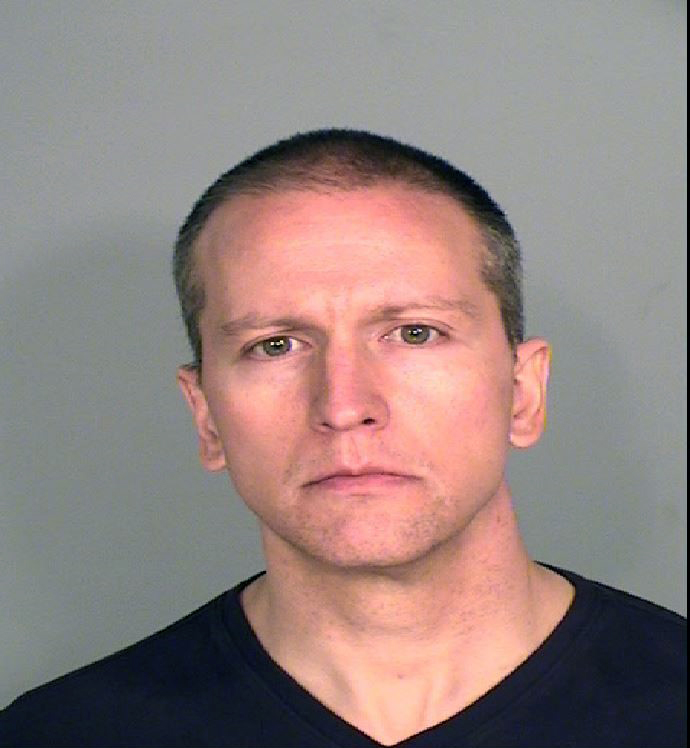
Derek Chauvin. | Source: Handout / Getty
Keep reading to find a complete and detailed timeline of the ongoing quest to bring justice for George Floyd.
window.addEventListener(‘interaction’, function () {
setTimeout(function () {
var s = document.createElement(‘script’), el = document.getElementsByTagName(‘script’)[ 0 ];
s.async = true;
s.src=”https://platform.twitter.com/widgets.js”;
el.parentNode.insertBefore(s, el);
}, 1000)
});
The post Justice For George Floyd Timeline: Witness Who Tried To Stop Murder Wins $150K Settlement appeared first on NewsOne.




